Poised to meet state demand
With the South Dakota Animal Disease Research and Diagnostic Laboratory on the South Dakota State University campus, Dr. Gary Gackstetter ’75 says the university’s professional program in veterinary medicine has an enormous advantage when recruiting prospective faculty and students.
Starting this fall, 20 students will comprise the program’s first cohort of veterinary students, which will have two years of classes at SDSU before transferring to the University of Minnesota for their final two years and earning a Doctor of Veterinary Medicine. The aim is to have graduates return to South Dakota or stay in the Upper Midwest and contribute to the rural economy and agricultural systems as veterinarians.
Previously, South Dakota was able to place only a few qualified students at the Iowa State University College of Veterinary Medicine and a formal agreement between legislatures would provide only six students with Iowa’s in-state tuition rate, and the state of South Dakota would pay the difference between resident and nonresident tuition.
The collaboration with the University of Minnesota will allow up to 20 students to attend veterinary school. The top six students could see a potential cost savings from a tuition assistance option of up to $100,000, over all four years of veterinary school. If these top six students choose to accept these funds, they can elect to pay it back over time or work in South Dakota and have the loan forgiven. Other South Dakota residents in the new veterinary program will also receive some tuition assistance, but without a payback commitment.
“Veterinarians are in high demand, not only in South Dakota but also throughout the region and the nation,†said Dustin Oedekoven ’00, the state veterinarian. “The SDSU professional program in veterinary medicine really sets out to meet that need, especially in the food animal medicine or rural veterinary medicine areas. There’s a growing need in our state.
“Veterinary medicine is a diverse field with specialization in various areas, such as swine or dairy specialists,†he continued. “We need those doctors, but we need doctors who are able to take the general farm calls, also take care of the ranch dog or barn cat and be that all-around veterinarian. All of those areas are important, and this program is an opportunity to meet those needs.â€
How to measure success
Gackstetter, who started in November 2019 as the first director of the professional program in veterinary medicine, has been busy coordinating with the University of Minnesota, recruiting students and hiring faculty for the program.
“My goal is to build a relevant program, assemble all the teaching and lab facilities, hire exceptional faculty and purchase teaching equipment to get the program launched and in the air as soon as possible,†he said. “As an epidemiologist and a veterinarian, I look for patterns. If I can get to a pattern of highly proficient students arriving at Minnesota who will come back to South Dakota when they graduate, then I’m going to consider this program a huge success.
 And Oedekoven is looking forward to working with those graduates, especially in a state that has many more cattle living within its borders than people.Â
And Oedekoven is looking forward to working with those graduates, especially in a state that has many more cattle living within its borders than people.Â
“One of my roles is serving as the director of the state’s veterinary licensing board and I know our citizens’ expectation for animal health and treatment of their animals is high, he said. “Because of the rural veterinarian component, students will have the opportunity to interact with our state’s veterinarians to actually see how that work is conducted. And it’ll be a good opportunity for the practitioners
to give back by helping teach the next generation and potentially recruiting them to work alongside them after graduation.â€
Gackstetter is committed to a robust collaborative partnership with the University of Minnesota College of Veterinary Medicine.
 “In partnership with the University of Minnesota, we will work very hard at SDSU to teach the basic veterinary sciences component, as well as introduce some early clinical skills and provide an equivalent education as would happen in St. Paul,†he said. “We can do that and at the same time help Minnesota balance its classes with a set of students interested in food animal, mixed animal, including companion animals, and we get to teach our 20 students with a rural focus.
“In partnership with the University of Minnesota, we will work very hard at SDSU to teach the basic veterinary sciences component, as well as introduce some early clinical skills and provide an equivalent education as would happen in St. Paul,†he said. “We can do that and at the same time help Minnesota balance its classes with a set of students interested in food animal, mixed animal, including companion animals, and we get to teach our 20 students with a rural focus.
“When you’re a veterinarian, you’re going to care for all different types of animals and you should be able to move from goats and chickens to cats and dogs to horses and cows, and everything in between.â€Â
– Matt Schmidt







